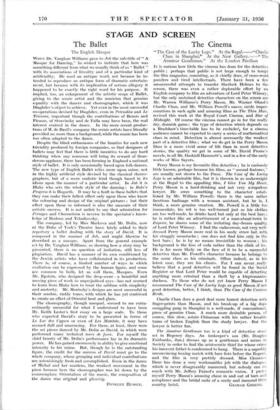The Ballet STAGE AND SCREEN
The English Masque WHEN Dr. Vaughan Williams gave to Job the sub-title of " A. Masque for Dancing," he wished to indicate that here was something different from what we usually think of as " Ballet " with its associations of frivolity and of a particular kind of artificiality. He used an antique word, not because he in- tended to reproduce an antique form of dramatic entertain- ment, but because with its implication of serious allegory it happened to be exactly the right word for his purpose. It implied, too, an enlargement of the artistic scope of Ballet, giving to the scenic artist and the musician that genuine equality with the dancer and choreographer, which it was Diaghilev's object to achieve. Yet even in the most successful co-operations devised by Diaghilev, even in Pe/ems/aka and Le Tricorne, important though the contributions of Benois and Picasso, of Stravinsky and de Falla may have been, the real interest centred in the dance. In the more recent produc- tions of M. de Basil's company the scenic artists have literally provided no more than a background, while the music has been too often adapted to the dance.
Despite the blind enthusiasms of the fanatics for each new triviality produced by foreign companies, so that designers of ballets may feel that there is little incentive to do any hard thinking when any nonsense will bring its reward of thun- derous applause, there has been forming in England a national, style of ballet. It is only occasionally based upon folk-dances. The new type of English Ballet relies more upon mime, not; in the highly artificial style devised by the classical choreo- graphers, but of a more realistic kind though based in its idiom upon the manner of a particular artist. In Job it is Blake who sets the whole style of the dancing ; in Rake's Progress it is Hogarth. It may be a fault in these ballets that they can make their fullest effect only upon those who know the colouring and design of the original pictures ; but their effect upon those so informed is also the measure of their artistic success. It is not unfair to say that admiration for Presages and Choreartium is inverse to the spectator's know- ledge of Braluns and Tchaikovsky.
The company, led by Miss Markova and Mr. Dolin, now at the Duke of York's Theatre have lately added to their repertory a ballet dealing with the story of David. It is composed in the manner of Job, and might likewise be described as a masque.. Apart from the general example set by Dr. Vaughan Williams, as showing how a story may be' presented, there is no question of imitation, still less of plagiarism. David has a manner of its own conditioned by the Jewish artists who have collaborated in its production. There is, of course, a limited number of ways in which, exaltation can be expressed by the human figure, and some are common to both, let us call them, Masques. Even Mr. Epstein, who designed the drop-scene—a beautiful and moving piece of work to unprejudiced eyes—has not scorned to learn from Blake how to treat the sublime with simplicity and austerity. Mi. Meninsky's designs arc most successful in their sombre, ruddy tones, with which he has yet contrived to create an effect of Oriental heat and glare.
The choreography, though unequal, seemed to me extra- ordinarily successful for what I understand to have been Mr. Keith Lester's first essay on a large scale. To those who expected David's story to be presented in terms of Le Lac des Cygnes or even of Les Matelots,- it may have seemed dull and unamusing. For them, at least, there were the set pieces danced by Mr. Dolin as David, in which were performed many technical tours de force. For myself the chief beauty of Mr. Dolin's performance lay in its dramatic power. He has gained enormously in ability to give emotional intensity to his mime. But, though he is the outstanding figure, the credit for the success of David must go to the whole company, whose grouping and individual contributions are astonishingly fresh and accomplished. Even in the dance of Michal and her maidens, the weakest movement in the piece because here the choreographer was let' down by the commonplace Orientalism of the music, the composition of the dance was original and pleasing.
DYNELEY HUSSEY.










































 Previous page
Previous page